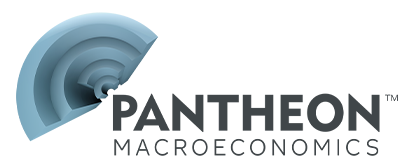US Publications
Below is a list of our US Publications for the last 5 months. If you are looking for reports older than 5 months please email info@pantheonmacro.com, or contact your account rep
Please use the filters on the right to search for a specific date or topic.
- ADP’s numbers have considerably understated the initial official estimates of private payrolls this year.
- Reliable surveys suggest an initial private print of 75K-to-100K in November, still too soft for comfort.
- A raft of indicators point to consumer weakness in Q4. We think spending will rise by only around ½%.
- Lower immigration, AI, tariffs and federal job cuts have potential to lift the natural unemployment rate...
- ...But firms are filling openings more easily and plan to slow wage growth, pointing to excess unemployment.
- No signs of excessive unemployment by state or by sector, indicative of a still-low equilibrium rate.
Core goods inflation likely to retreat in H1 2026.
- Investors see a near-90% chance of the FOMC easing next week, back to levels before October’s meeting.
- Sometimes, the Chair moves markets during the blackout via the WSJ, but that seems unlikely now.
- Manufacturing payrolls have fallen materially in 2025, but likely aren’t a canary in the coalmine this time.
- The average effective tariff rate is currently just 12%, far short of the near-20% widely expected in spring.
- China imports have dived; more imports than expected from Canada and Mexico are USMCA-compliant.
- The plunge in the Cass Freight Index looks alarming, but it probably is overstating weakness in industry.
EXPECT AN EXTENDED FED EASING CYCLE...
- ...DRIVEN BY A WEAK LABOR MARKET AND FALLING INFLATION
Improving slightly, but investment still soft outside of tech.
Weak jobs market continues to depress consumers.
Weak September sales are a sign of what's to come.
Core PCE inflation set to undershoot the FOMC’s forecast in Q4.
- PPI and CPI data imply the core PCE deflator rose by just 0.22% in September.
- Goods price rises are slowing and retailers, especially auto retailers, are still partially absorbing the tariffs.
- The Conference Board’s consumer survey implies the labor market need more support from the FOMC.
- We look for a subpar 0.3% increase in September retail sales, consistent with real spending edging down.
- Food service sales likely fell sharply, while the more reliable indicators of control sales were soft.
- Bloomberg Second Measure data, Google search volumes and hotel room occupancy signal a weak Q4.
- Growth in average hourly earnings is resilient because fewer entry level workers are being hired...
- ...Rising unemployment, the low quits rate and a wide range of surveys all point to an underlying slowdown.
- The NY Fed’s Williams still sees room to ease policy “...in the near term”, bolstering our December call.
Boost from lower rates likely has only a bit further to run.
Payrolls flattered by the seasonals; rising unemployment keeps a December easing in play.
December hangs in the balance, but substantial easing probably still lies ahead.
- The pick-up in payrolls was a by-product of the most generous September seasonal on record...
- ...The chances of a downward revision are very high; October’s report will be substantially weaker too.
- The rise in the unemployment rate is being fuelled by new entrants and layoffs; expect more to come in Q4.
Dip in mortgage rates providing only a small tailwind.
- The BLS’ new data calendar means today’s employment report is make-or-break for a December easing.
- The GDPNow model is running a bit too hot; GDP growth in Q3 of about 31/2% seems more likely.
- October’s jump in WARN filings is due to new laws in Washington state; the trend is rising moderately.
